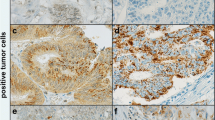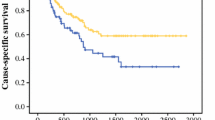Abstract
CXC Chemokine Ligand 10 (CXCL10), an interferon-inducible protein, has been demonstrated to inhibit the proliferation and metastasis in many tumors. In this study, we focus on the expression of CXCL10 in stage II and III colorectal cancer (CRC) and its correlation with metastasis. Real-time reverse-transcription polymerase chain reaction (real-time RT-PCR) and RT-PCR were performed in 36 snap-frozen CRC tissues with recurrence and 28 CRC tissues without recurrence to examine CXCL10 expression. For further examination in mRNA level, three CRC-metastasis-derived cell lines (SW620, Lovo, Colo205) and three primary-CRC-derived ones (SW480, Caco-2, HCT116) were also subjected to real-time RT-PCR. Analysis showed that CXCL10 down-regulated in CRC with recurrence both in tissues and cells (P < 005). Immunohistochemistry was also performed in 118 paraffin-embedded specimens. CRC were scored as strong and low CXCL10 expressers (−/+ and ++/+++, respectively). The correlation between clinicopathological or molecular variables and survival was analyzed. Lowly expressed CXCL10 mRNA were detected in snap-frozen tissues with recurrence (P < 0.05) and in cell lines derived from CRC metastases (SW620, Lovo, Colo205). No significant correlation was found between CXCL10 level detected by immunostaining and tumor location, size, histological type, lymphvascular invasion, perineural invasion or TNM stage. However, patients with lower levels of CXCL10 expression showed the poorer prognosis [low expression 70% (57/81) versus strong expression 27% (10/37); P < 0.05]. Kaplan–Meier curves comparing different CXCL10 expression levels with survival showed highly significant separation (P < 0.05, log-rank test). The Cox proportional hazards regression model also showed that low CXCL10 expression was an independent adverse prognosticator in stage II and III CRC (P < 0.05). We concluded that detection of CXCL10, as a prognostic marker for stage II and III CRC patients, may contribute to predicting clinical outcome.



Similar content being viewed by others
References
Weitz J, Koch M, Debus J, Höhler T, Galle PR, Büchler MW (2005) Colorectal cancer. Lancet 365:153–165
Cserni G (2003) Nodal staging of colorectal carcinomas and sentinel nodes. J Clin Pathol 56:327–335
de Gramont A, Tournigand C, André T, Larsen AK, Louvet C (2007) Adjuvant therapy of stage II and III colon cancer. Semin Oncol 34:S37–S40
Carmeliet P (2005) Angiogenesis in life, disease and medicine. Nature 438:932–936
Singh UP, Singh S, Iqbal N, Weaver CT, McGhee JR, Lillard JW Jr (2003) IFN-g-inducible chemokines enhance adaptive immunity and colitis. J Interferon Cytokine Res 23:591–600
Lazzeri E, Romagnani P (2005) CXCR3-binding chemokines: novel multifunctional therapeutic targets. Curr Drug Targets Immune Endocr Metab Disord 5:109–118
Sgadari C, Angiolillo AL, Cherney BW, Pike SE, Farber JM, Koniaris LG, Vanguri P, Burd PR, Sheikh N, Gupta G, Teruya-Feldstein J, Tosato G (1996) Interferon-inducible protein-10 identified as a mediator of tumor necrosis in vivo. Proc Natl Acad Sci USA 93:13791–13796
Kanegane C, Sgadari C, Kanegane H, Teruya-Feldstein J, Yao L, Gupta G, Farber JM, Liao F, Liu L, Tosato G (1998) Contribution of the CXC chemokines IP-10 and Mig to the antitumor effects of IL-12. J Leukoc Biol 64:384–392
Sato E, Fujimoto J, Toyoki H, Sakaguchi H, Alam SM, Jahan I, Tamaya T (2007) Expression of IP-10 related to angiogenesis in uterine cervical cancers. Br J Cancer 96:1735–1739
Biragyn A, Tani K, Grimm MC, Weeks S, Kwak LW (1999) Genetic fusion of chemokines to a self tumor antigen induces protective, T-cell dependent antitumor immunity. Nat Biotechnol 17:253–258
Narvaiza I, Mazzolini G, Barajas M, Duarte M, Zaratiegui M, Qian C, Melero I, Prieto J (2000) Intratumoral coinjection of two adenoviruses, one encoding the chemokine IFN-gamma-inducible protein-10 and another encoding IL-12, results in marked antitumoral synergy. J Immunol 164:3112–3122
Feldman AL, Friedl J, Lans TE, Libutti SK, Lorang D, Miller MS, Turner EM, Hewitt SM, Alexander HR (2002) Retroviral gene transfer of interferon-inducible protein 10 inhibits growth of human melanoma xenografts. Int J Cancer 99:149–153
Maru SV, Holloway KA, Flynn G, Lancashire CL, Loughlin AJ, Male DK, Romero IA (2008) Chemokine production and chemokine receptor expression by human glioma cells: role of CXCL10 in tumour cell proliferation. J Neuroimmunol 199:35–45
Datta D, Flaxenburg JA, Laxmanan S, Geehan C, Grimm M, Waaga-Gasser AM, Briscoe DM, Pal S (2006) Ras-induced modulation of CXCL10 and its receptor splice variant CXCR3-B in MDA-MB-435 and MCF-7 cells: relevance for the development of human breast cancer. Cancer Res 66:9509–9518
Giese NA, Raykov Z, DeMartino L, Vecchi A, Sozzani S, Dinsart C, Cornelis JJ, Rommelaere J (2002) Suppression of metastatic hemangiosarcoma by a parvovirus MVMp vector transducing the IP-10 chemokine into immunocompetent mice. Cancer Gene Ther 9:432–442
Keyser J, Schultz J, Ladell K, Elzaouk L, Heinzerling L, Pavlovic J, Moelling K (2004) IP-10-encoding plasmid DNA therapy exhibits anti-tumor and anti-metastatic efficiency. Exp Dermatol 13:380–390
Reckamp KL, Figlin RA, Moldawer N, Pantuck AJ, Belldegrun AS, Burdick MD, Strieter RM (2007) Expression of CXCR3 on mononuclear cells and CXCR3 ligands in patients with metastatic renal cell carcinoma in response to systemic IL-2 therapy. J Immunother 30:417–424
Mendiratta SK, Quezada A, Matar M, Thull NM, Bishop JS, Nordstrom JL, Pericle F (2000) Combination of interleukin 12 and interferon a gene therapy induces a synergistic antitumor response against colon and renal cell carcinoma. Hum Gene Ther 11:1851–1862
Zilocchi C, Stoppacciaro A, Chiodoni C, Parenza M, Terrazzini N, Colombo MP (1998) Interferon g-independent rejection of interleukin 12-transduced carcinoma cells requires CD4+ T cells and granulocyte/macrophage colony-stimulating factor. J Exp Med 188:133–143
Li G, Tian L, Hou JM, Ding ZY, He QM, Feng P, Wen YJ, Xiao F, Yao B, Zhang R, Peng F, Jiang Y, Luo F, Zhao X, Zhang L, Zhou Q, Wei YQ (2005) Improved therapeutic effectiveness by combining recombinant CXC chemokine ligand 10 with cisplatin in solid tumors. Clin Cancer Res 11:4217–4224
Yao L, Pike SE, Setsuda J, Parekh J, Gupta G, Raffeld M, Jaffe ES, Tosato G (2000) Effective targeting of tumor vasculature by the angiogenesis inhibitors vasostatin and interleukin-12. Blood 6:1900–1905
Zipin-Roitman A, Meshel T, Sagi-Assif O, Shalmon B, Avivi C, Pfeffer RM, Witz IP, Ben-Baruch A (2007) CXCL10 promotes invasion related properties in human colorectal carcinoma cells. Cancer Res 67:3396–3405
Naschberger E, Croner RS, Merkel S, Dimmler A, Tripal P, Amann KU, Kremmer E, Brueckl WM, Papadopoulos T, Hohenadl C, Hohenberger W, Stürzl M (2008) Angiostatic immune reaction in colorectal carcinoma: impact on survival and perspectives for antiangiogenic therapy. Int J Cancer 123:2120–2129
Bertagnolli MM (2007) Chemoprevention of colorectal cancer with cyclooxygenase-2 inhibitors: two steps forward, one step back. Lancet Oncol 8:439–443
Coussens LM, Werb Z (2002) Inflammation and cancer. Nature 420:860–867
Albini A, Sporn MB (2007) The tumour microenvironment as a target for chemoprevention. Nat Rev Cancer 7:139–147
de Visser KE, Eichten A, Coussens LM (2006) Paradoxical roles of the immune system during cancer development. Nat Rev Cancer 6:24–37
Greten FR, Eckmann L, Greten TF, Park JM, Li ZW, Egan LJ, Kagnoff MF, Karin M (2004) IKK beta links inflammation and tumorigenesis in a mouse model of colitis-associated cancer. Cell 118:285–296
Pardoll D (2001) T cells and tumours. Nature 411:1010–1012
Pollard JW (2004) Tumour-educated macrophages promote tumour progression and metastasis. Nat Rev Cancer 4:71–78
Folkman J (1971) Tumor angiogenesis: therapeutic implications. N Engl J Med 285:1182–1186
Folkman J (2006) Angiogenesis. Annu Rev Med 57:1–18
Hurwitz H, Fehrenbacher L, Novotny W, Cartwright T, Hainsworth J, Heim W, Berlin J, Baron A, Griffing S, Holmgren E, Ferrara N, Fyfe G, Rogers B, Ross R, Kabbinavar F (2004) Bevacizumab plus irinotecan, fluorouracil, and leucovorin for metastatic colorectal cancer. N Engl J Med 350:2335–2342
Sato E, Fujimoto J, Toyoki H, Sakaguchi H, Alam SM, Jahan I, Tamaya T (2007) Expression of IP-10 related to angiogenesis in uterine cervical cancers. Br J Cancer 96:1735–1739
Greene FL, Page DL, Fleming ID, Fritz A, Balch CM, Haller DG, Morrow M (2002) AJCC cancer staging manual, 6th edn. Springer, New York
Trarbach T, Kubicka S, Hacker U, Ridwelski K, Reinacher-Schick A (2008) Adjuvant therapy of colon carcinoma. Onkologie 31:19–23
De Dosso S, Sessa C, Saletti P (2009) Adjuvant therapy for colon cancer: present and perspectives. Cancer Treat Rev 35:160–166
Author information
Authors and Affiliations
Corresponding author
Rights and permissions
About this article
Cite this article
Jiang, Z., Xu, Y. & Cai, S. CXCL10 expression and prognostic significance in stage II and III colorectal cancer. Mol Biol Rep 37, 3029–3036 (2010). https://doi.org/10.1007/s11033-009-9873-z
Received:
Accepted:
Published:
Issue Date:
DOI: https://doi.org/10.1007/s11033-009-9873-z




